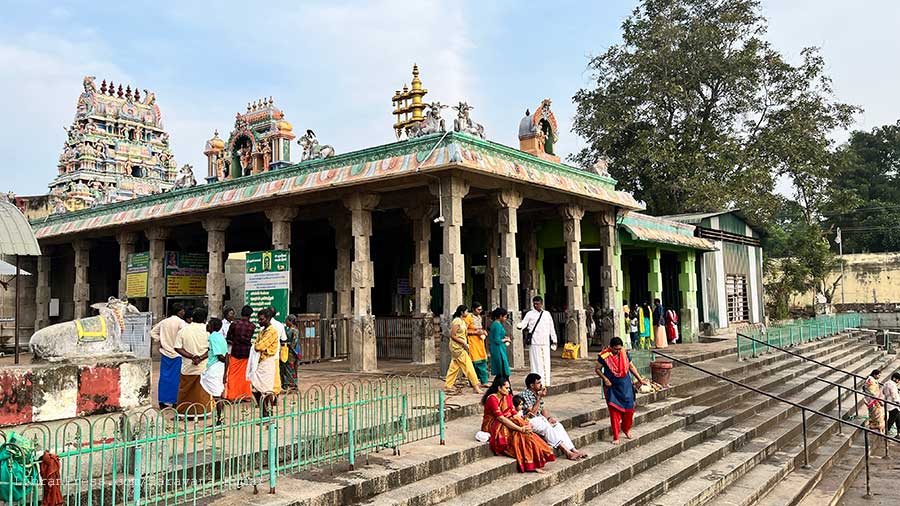Most devotees visit the Budhan Temple in Thiruvenkadu on the advice of their astrologers. Whether or not you believe in astrology, a visit here promises a unique and enriching experience.
The Budhan Temple boasts a rich history. It features stunning architecture and exudes a profound spiritual aura. It is a must-visit destination for devotees, scholars, and travelers. They seek wisdom, peace, and a connection to divine energies.
Travel to the serene village of Thiruvenkadu, near Sirkazhi (Seergali) in Tamil Nadu’s Mayiladuthurai district, and immerse yourself in the enriching experience of the Budhan Temple.
The actual name of this ancient Hindu temple is Swetharanyeswarar Temple. However, it is more popular as the Budhan Temple. Like many temples in Tamil Nadu, this temple’s main deity is Lord Shiva, known as Swetharanyeswarar. His consort is Brahmavidyambigai.
This sacred site is one of the nine Navagraha Sthalas. It holds special reverence as the abode of Budhan—the planet Mercury.
In this blog post, I will take you through its rich history and explore its distinctive architecture and spiritual significance. Let’s also examine its vibrant festivals and many reasons why this temple deserves a place on your travel list.
A Glimpse into the History of Thiruvenkadu Budhan Temple
The Swetharanyeswarar Temple has a rich history and its roots trace back to the Chola dynasty. The Chola dynasty is renowned for its contributions to art, architecture, and spirituality. Stone inscriptions within the temple reveal the patronage of Chola kings. Kings like Aditya Chola and Rajaraja Chola played a pivotal role in its development.
The temple is mentioned in the 7th-century Tamil Saiva canonical work, Tevaram. This was composed by the Nayanar saint poets Appar, Sundarar, and Sambandar. This recognition earns it the status of a Paadal Petra Sthalam —a temple revered in sacred Tamil poetry.
Thiruvenkadu means “sacred white forest” and derives from its Sanskrit name Shwetaranya. It is also known as Adi Chidambaram. The name draws parallels with the famous Chidambaram Nataraja Temple. This is due to the presence of the Chidambara Rahasyam, which is a mystical representation of the divine.
Thiruvenkadu Budhan Temple Complex
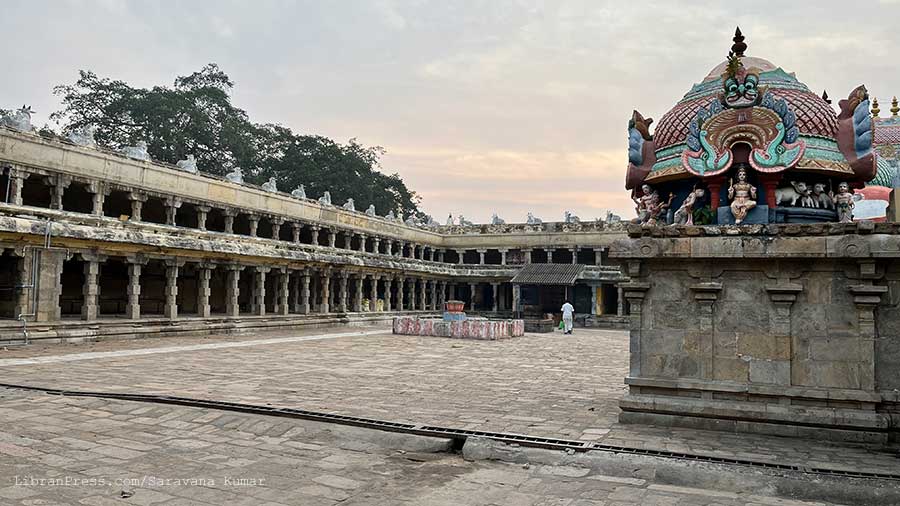
The temple is one of six sacred sites equivalent to Kasi (Varanasi) in spiritual significance. The other sites are Rameswaram, Srivanchiyam, Gaya, Thiriveni Sangamam, and Thilatharpanapuri.
The temple has a legend that revolves around the demon Maruthuvasuran. After receiving boons from Lord Brahma, he misused his powers. He tormented saints and devotees. In response to their pleas, Lord Shiva took the fierce form of Agora Murthi, vanquished the demon, and restored peace. This incarnation of Shiva as Agora Murthi is unique to the temple. It draws devotees seeking protection and spiritual strength.
Another fascinating tale involves Budhan (Mercury). Budhan is the son of Chandra (Moon) and Tara, the wife of Brihaspati (Jupiter). After a complex divine drama, Budhan, seeking redemption, performed penance to Lord Shiva at Thiruvenkadu. Pleased with his devotion, Shiva blessed him as one of the Navagrahas, making this temple the sacred seat of Mercury.
Architectural Marvel of the Temple
The Swetharanyeswarar Temple is a testament to the architectural prowess of the Chola dynasty. The temple complex spans approximately two acres. One enters the temple through a majestic seven-tiered Rajagopuram. At the entrance, you will witness the intricate carvings that depict mythological stories and divine figures. The temple faces east. It features two towering gopurams on its eastern and western sides. Surrounding the temple are five prakarams (enclosures) that enhance its grandeur.
The main sanctum houses the lingam of Swetharanyeswarar. It represents Lord Shiva. A separate shrine is dedicated to Brahmavidyambigai. This symbolizes knowledge and wisdom.
The temple’s unique feature is the separate sannidhi for Budhan, located opposite the Chandra Theertham tank, where devotees offer prayers to rectify Budha Dosham (astrological afflictions caused by Mercury’s unfavorable placement)
The temple also boasts three sacred tanks. They are Surya Theertham, Agni Theertham, and Chandra Theertham. These are believed to have been formed by drops from Lord Shiva’s three eyes, symbolizing the Sun, Fire, and Moon.
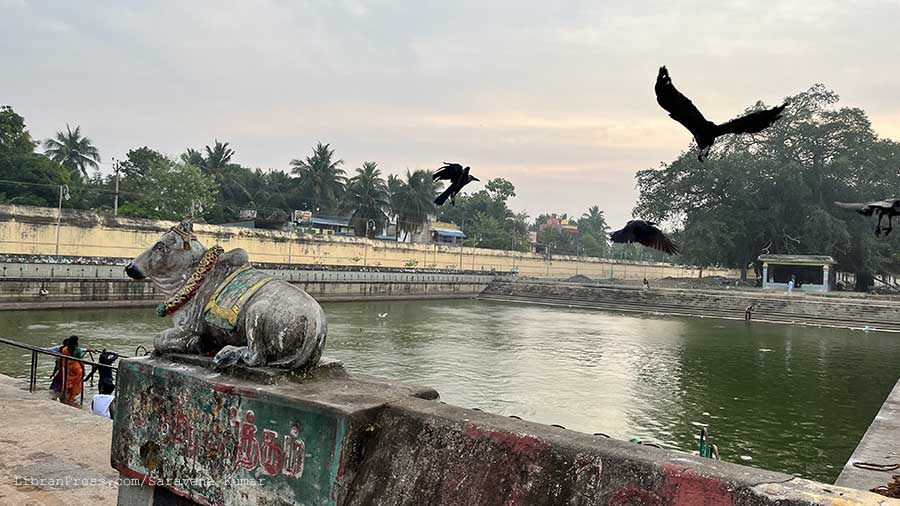
These tanks are considered spiritually potent. Bathing in them is said to cleanse devotees of ailments. It is also believed to address infertility and other challenges.
The temple’s Kalyana Mandapam, used for reenacting celestial weddings, and various mandapams for meditation and prayers add to its architectural and spiritual richness.
The Agora Murthi shrine depicts Shiva’s fierce form. In the Nataraja shrine, the deity holds seven instruments and weapons. These are Vetalam, Khadgam, Udukku, Mani, Kedayam, Kapalam, and Trisulam. These elements make the temple a unique blend of serenity and divine power.
The Pillai Idukkai Amman shrine is another highlight. It portrays Goddess Parvati holding the child Sambandar. This symbolizes maternal compassion and divine grace.
Spiritual Significance of the Budhan Temple
As a Navagraha Sthala dedicated to Budhan (Mercury), the temple holds immense astrological and spiritual importance. In Vedic astrology, Budhan governs intellect, wisdom, communication, and skills in arts, music, mathematics, astrology, and languages.
An unfavorable placement of Mercury in one’s birth chart (Budha Dosham) can lead to challenges. These challenges may include poor academic performance, nervous disorders, and speech impediments. It can also result in difficulties in marriage and progeny.
Devotees visit the temple to seek Budhan’s blessings for:
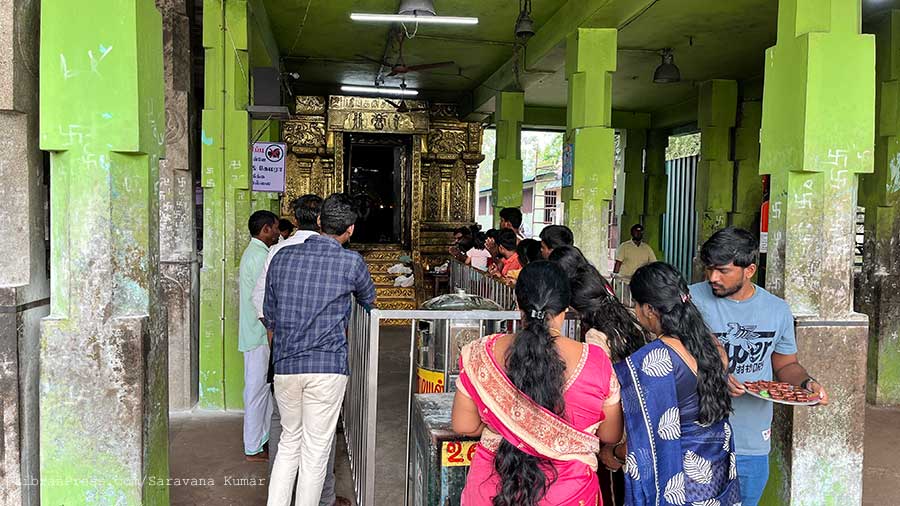
Educational Excellence: Budhan is as the wisest of the Navagrahas. Students or scholars struggling with academics often perform poojas (prayers and rituals) here. These rituals are done to enhance focus and intelligence.
Relief from Health Issues: Worshipping Budhan on Wednesdays is believed to alleviate nervous disorders. It can also help with respiratory issues like asthma. Additionally, it may reduce speech impediments.
Marriage and Progeny: The temple is renowned for resolving Puthira Dosham (obstacles in childbirth). Bathing in the three sacred tanks and praying to Pillai Idukkai Amman is said to bless childless couples with progeny.
Career and Business Success: Budhan’s influence extends to eloquence, commerce, and political success. This makes the temple a destination for professionals seeking growth.
Spiritual Cleansing: The temple’s tanks and rituals are believed to cleanse devotees of past karmas and bring mental peace.
A recommended ritual involves lighting 17 herbal oil lamps. You should circumambulate the Budhan shrine 17 times. Additionally, offer annadhanam (free food) to 17 people. (You can buy herbal oil lamps and other ritual items in the temple premises)
Devotees offer green cloth and full green moong dal (pachchai paruppu) to appease Budhan. They pray facing the northeast, Mercury’s direction.
Festivals and Rituals
The temple comes alive during its vibrant festivals, with the Annual Chariot Festival in February being the most prominent. This 10-day celebration includes a special day dedicated to Agora Murthi. It draws devotees from surrounding villages who seek blessings. They wish for prosperity and protection. Other festivals include Maha Shivaratri, Navratri, and special poojas on Wednesdays, considered auspicious for Budhan worship.
The temple’s prasadam offerings include venn pongal, puliyodharai, chakkarai pongal, and curd rice. Devotees cherish them for their taste. They also hold spiritual significance.
Why You Should Explore Thiruvenkadu Budhan Temple
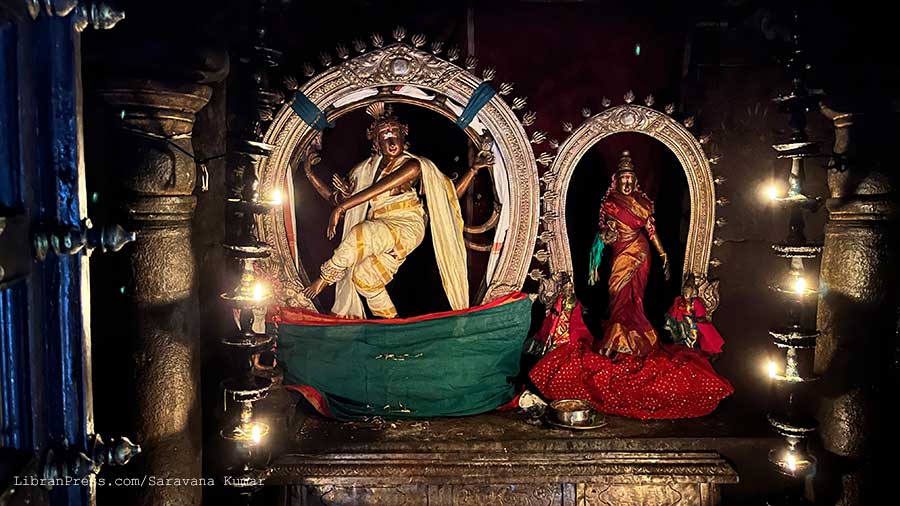
1. Spiritual Rejuvenation: The temple’s tranquil ambiance provides a profound sense of peace. The sacred tanks and divine vibrations contribute to spiritual cleansing. There is a belief that bathing in the Surya, Agni, and Chandra Theerthams will wash away physical and mental afflictions.
2. Astrological Remedies: For those facing challenges due to Mercury’s placement in their horoscope, the temple provides a sacred space. Here, individuals can perform targeted poojas and rituals. These actions help mitigate Budha Dosham.
3. Cultural and Historical Richness: The temple’s Chola-era architecture is remarkable. Its stone inscriptions are many. Its connection to Tamil Saiva literature makes it a treasure trove for history enthusiasts and scholars.
4. Unique Divine Presence: The rare Agora Murthi and Nataraja forms of Shiva are exceptional. Along with the Pillai Idukkai Amman shrine, they offer a unique spiritual experience not found in many other temples.
5. Accessibility: The temple is located 10 km from Sirkazhi. It is 26 km from Mayiladuthurai and 60 km from Kumbakonam. It is easily accessible by road or public transport. Its peaceful village setting provides a respite from urban chaos.
6. Connection to Navagraha Circuit: Thiruvenkadu is part of the Navagraha temple circuit around Kumbakonam. It is an essential stop for those undertaking a spiritual pilgrimage. This pilgrimage aims to balance planetary influences.
Practical Information for Visitors
Temple Timings: 6:00 AM to 12:00 PM and 4:00 PM to 9:00 PM.
Location: Thiruvenkadu, Mayiladuthurai District, Tamil Nadu, 10 km from Sirkazhi, 26 km from Mayiladuthurai, and 60 km from Kumbakonam.
How to Reach: The nearest railway station is Mayiladuthurai, with regular buses from Sirkazhi and Vaitheeswaran Koil. Direct trains like the Cholan Express from Chennai are also available, though delays are common. (Reference: Trip Advisor)
Best Day to Visit: Wednesdays are ideal for Budhan worship.
Accommodation: You will find limited lodging in Thiruvenkadu. I would recommend staying in nearby Vaitheeswaran Koil, Thirukadaiyur, or Mayiladuthurai. The temple complex has several shops where you can buy prasadams and other ritual items.
Tips: Carry sufficient cash, as ATMs in nearby areas may not always function. You can also make payments via UPI. Avoid shops pressuring you to buy pooja items. Pre-register for special rituals if needed.
Conclusion

The Thiruvenkadu Budhan Temple is more than a place of worship. It is a spiritual haven where history, mythology, and astrology converge to offer solace and solutions. The temple is for those seeking wisdom, who want relief from astrological afflictions. It is also for those who want a deeper connection with the divine. This temple offers a transformative experience.
The Budhan temples architectural splendor, sacred tanks, and vibrant festivals make it a cultural gem. Its serene ambiance and divine energy inspire introspection and peace.
Plan your visit to this Navagraha temple to immerse yourself in its sacred rituals. Let the blessings of Lord Swetharanyeswarar and Budhan guide you toward a brighter, wiser future.

